A Blackwater and Shark Double-Dip Dive Trip in the South Atlantic
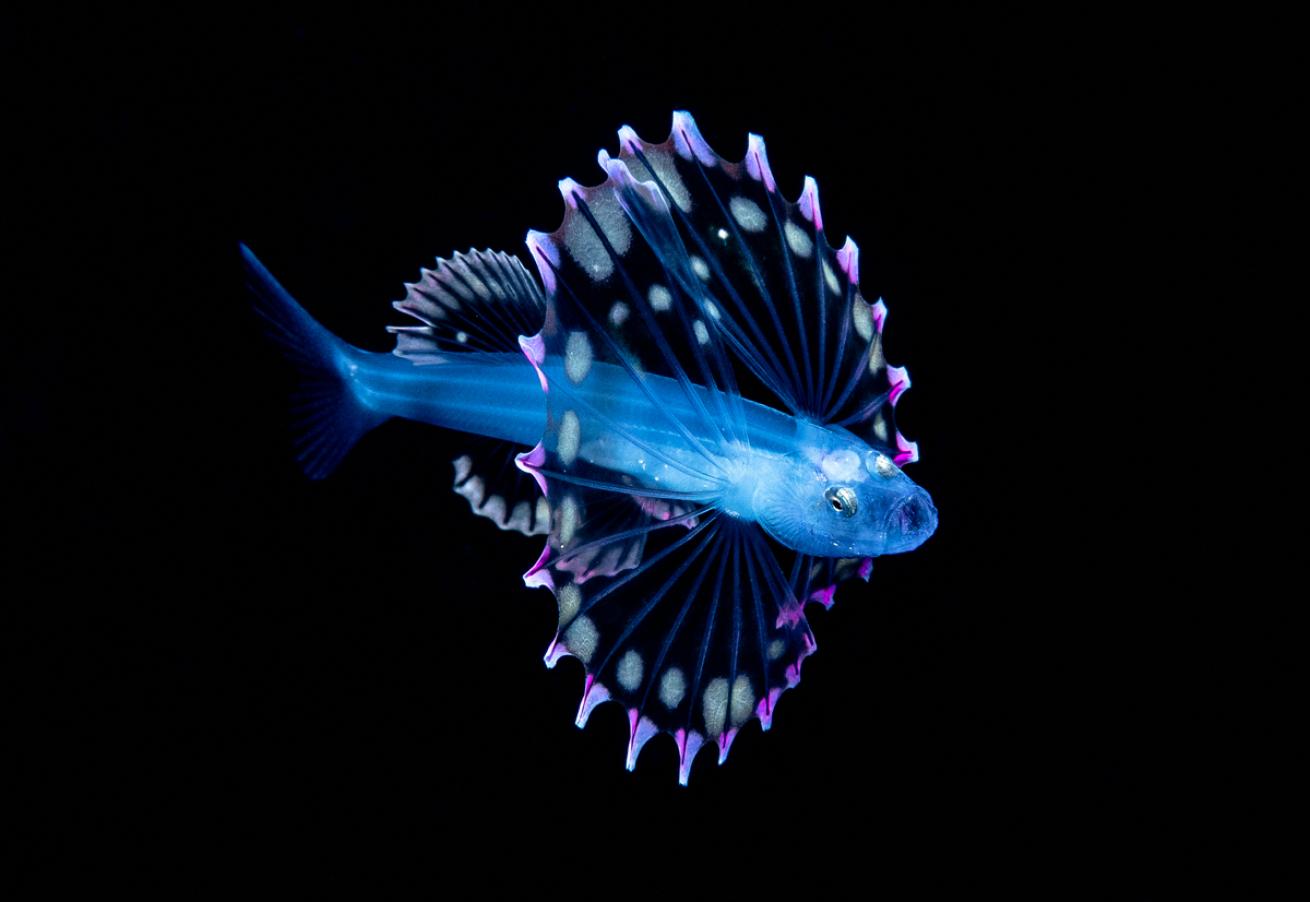
Brandon ColeA black-water creature sighting.
The old saying “fish out of water” had never been more painfully relevant. Starved for compressed air after a diving drought of lamentable duration, I was manic to make up for lost bottom time. Packing two trips into one was the perfect solution—a scuba twofer crafted to maximize underwater adventure and minimize travel hassle. I would combine Florida and the Bahamas, black-water and big sharks. Such a combo deal (on paper, more of a Kirk and Spock cyborg union than a classical pairing like Cozumel and cerveza) all but guaranteed a diverse, unforgettable dive experience. Epic and eclectic in one stroke. Brilliant.
Pretty much anywhere in southeast Florida can suffice for a generic scuba fix, but I specifically chose West Palm Beach as both destination and port of embarkation for my much-needed two-week reimmersion tour. Diver is widely spoken here. There are dive shops, dive boats, diver-friendly accommodations and, most importantly, great diving of all stripes, including black-water. The newish, addictive subgenre of specialized nighttime critter hunting is a shining star in West Palm Beach’s portfolio. As an added bonus, the super sharky waters of the Bahamas—practically in Florida’s backyard—entice powerfully from just the other side of the Gulf Stream. My course was set.
Come Blessed Night, Full of Who Knows What
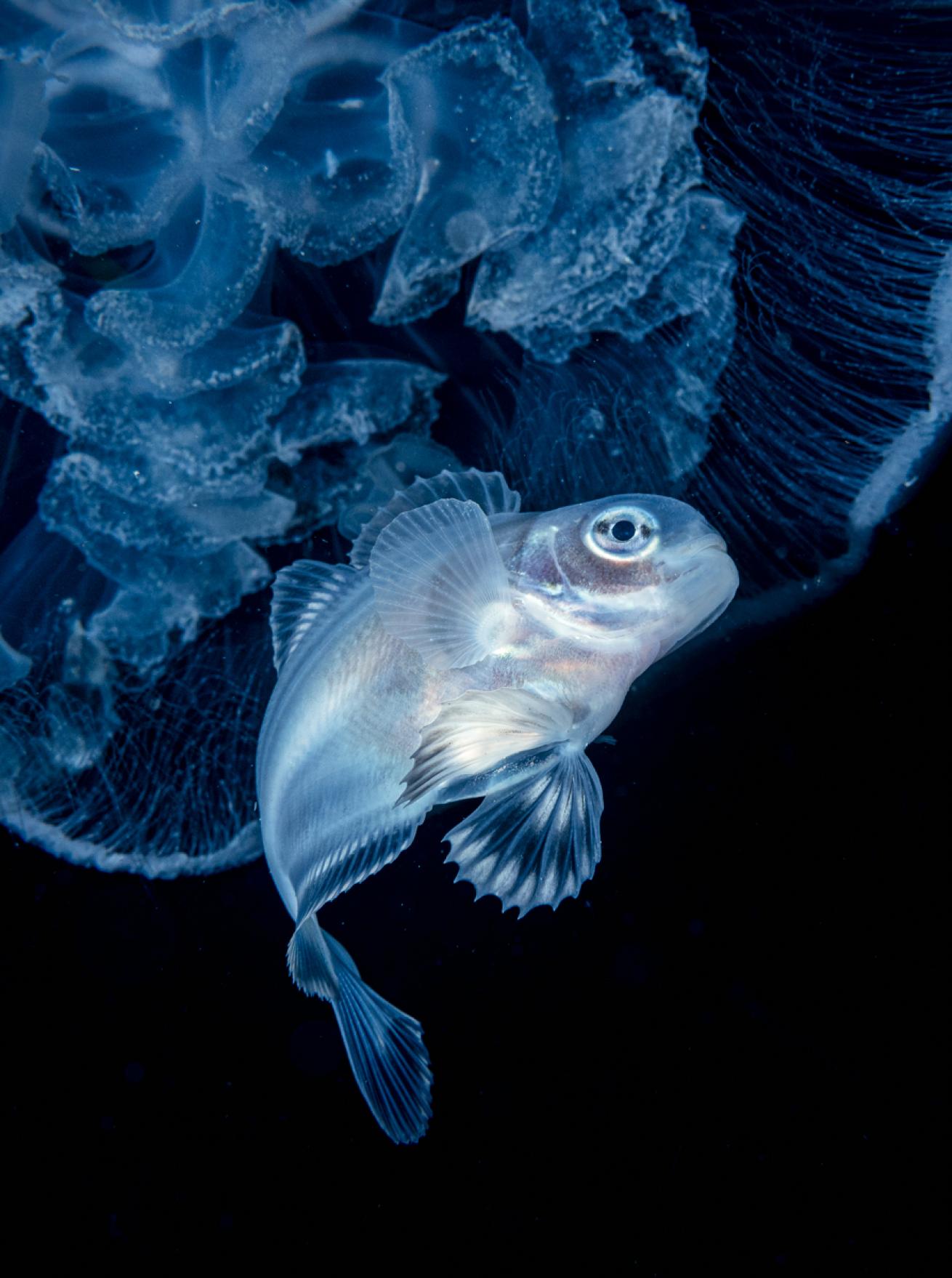
Brandon ColeA juvenile silver driftfish seeks refuge in a jellyfish’s tentacles.
My first day in the Sunshine State was not as advertised, but no matter. I came to Florida for its creatures of darkness, not to worship UV rays, and a steady drizzle could not dampen my spirits as I kitted up under leaden skies for a checkout dive at Phil Foster Park, aka Blue Heron Bridge. I had hours to kill and I wanted to flush out the cobwebs. A black-water expedition is not the place to find out that your regulator has given up the ghost or your camera is on the fritz. Much better to test the waters in 5 to 15 feet on an easy shore dive like Blue Heron and, if necessary, troubleshoot in situ. Thankfully, my muck dive at Phil Foster proved completely uneventful in the gear-failure department and pleasantly productive in terms of photo subjects. The arrow crabs, ugly-mugged batfish, cheeky seaweed blennies, octopuses hiding in bottles, juvenile angelfish and so much more had me charged up for the evening’s main event.
Finally, after interminable months, it was black-water time. We were here. Captain Bill of the 36-foot The Wetter the Better said “here” was 6 miles offshore in the Gulf Stream, southeast of West Palm Beach. I’ll have to take his word for it since my world was now defined by the beam of my light. My computer promised that I was 50 feet under the surface, but it was silent on the fact that there were 700 more feet of mystery beneath my fins. I could not ignore that, nor the feeling I was being watched. But by what? With any luck, the black void 360 degrees around me was populated by aliens galore. I only had to find them and introduce myself. First contact was with jellyfish the size of my fingernail. And then there were a few tiny, silvery fish flitting past, and something nigh invisible wiggling wildly with legs all over the place, but gone again before my brain could shift into first gear. All of this was interesting enough, but I had hoped for more. Switching my light from a wide, soft cone to a narrow, piercing beam, I rotated slowly in zero G, cutting through the blackness with my lightsaber. Minutes slipped by. Nothing.
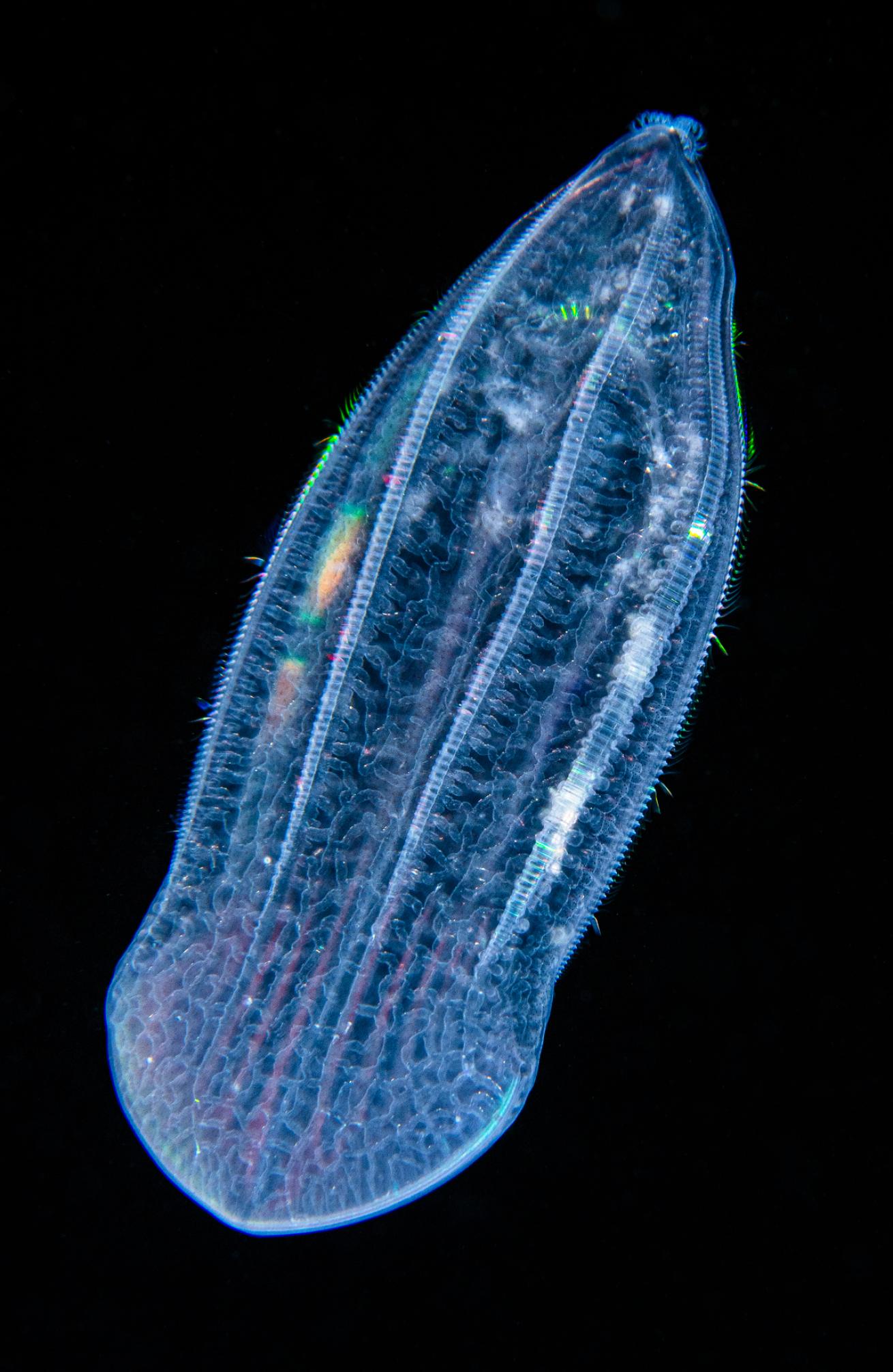
Brandon ColeA cigar comb jelly (Beroe forskalii).
My dive buddy Mike was a black-water Jedi master, veteran of hundreds of hours drifting in deep space. So when his green light flickered at me, I expected to be amazed. And indeed I was, repeatedly. He unveiled cool critter after even cooler critter: a juvenile swordfish half the size of a matchstick; two seahorses sailing through the night clinging to sprigs of sargassum weed; a post-larval tripod fish, its rainbow-hued fins encircling its waist like a tutu. I was gobsmacked by all of this ichthyological goodness. I even managed to spot some ETs on my own, including a larval moray eel, juvenile flyingfish, tonguefish, flounders, seethrough pelagic nudibranchs, and a freaky larval lobster holding firm to two salps. We had started in a slow patch, a biological desert really, but over the course of the 100-minute dive we eventually drifted into mother lode territory full of rare and remarkable planktonic microfauna, the majority of which were completely new to me.
So it is with black-water diving. In a way it’s liberating not knowing what to expect. No two black-water dives are the same, as there are a million different possible permutations of time and space and life forms intersecting. Some drifts are action-packed, with no chance to catch your breath between the nonstop oohs and aahs, while other dives are sleepy, without much more than plankto-snotballs for entertainment. Best just to give oneself over to the deep and see what happens.
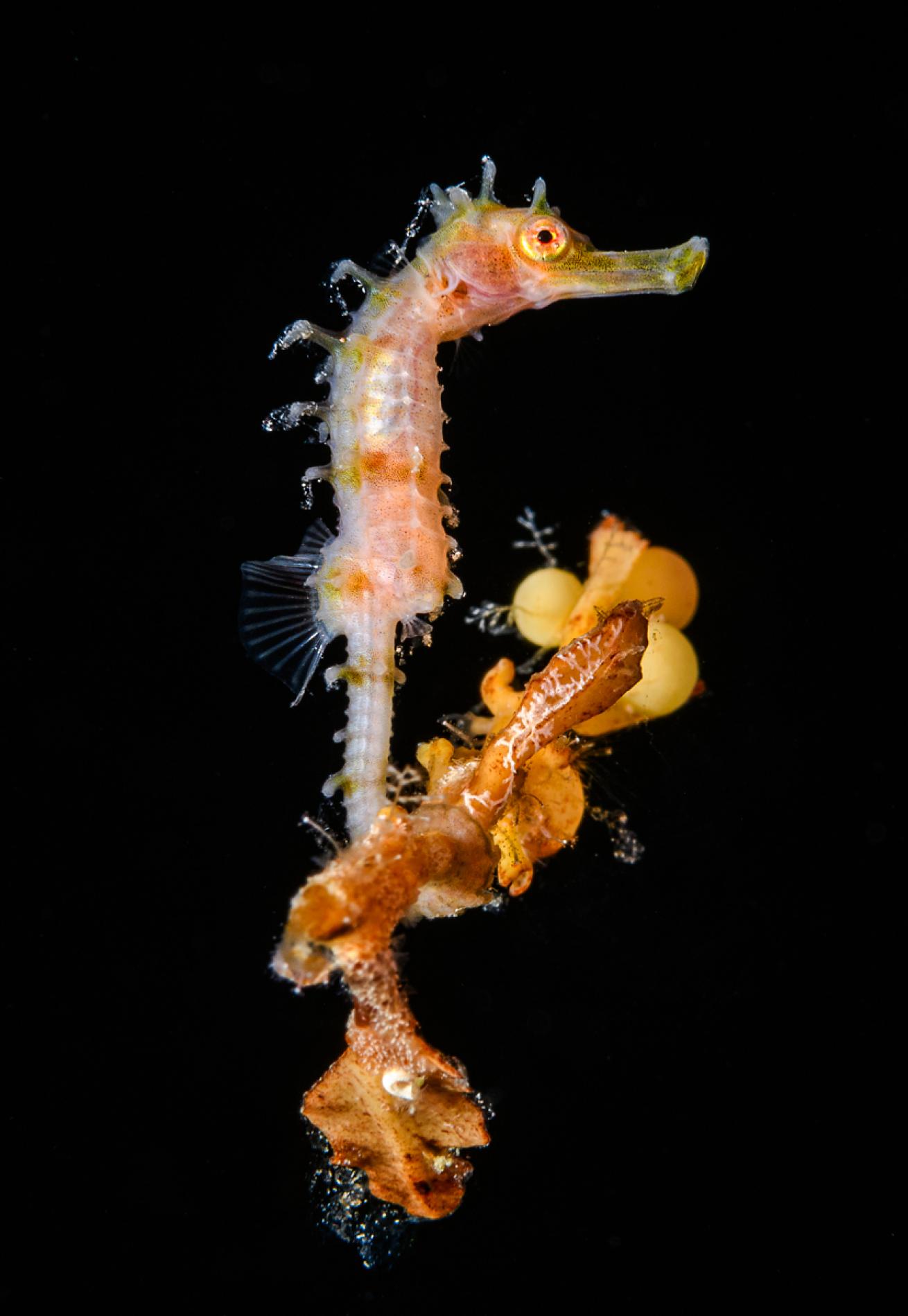
Brandon ColeA juvenile seahorse grasps a piece of floating sargassum in open water.
Not much happened the following night, and rough seas scrapped the next departure. But after Neptune’s mood mellowed, we tried again. The current was cranking at nearly 3 knots south to north when we jumped off the boat into the black. There was surface slop too, so we decided to stay close to the light array the crew had deployed.
Picture a 50-foot-tall chandelier pumping out some 100,000 total lumens from a dozen cleverly positioned LED torches, with an illuminated red surface buoy at the top and some lead weights hanging down at the bottom. MacGyvered to perfection over the years, it functions primarily as a safety device, helping divers stay oriented in this realm without other reference and making it easy for the boat to follow along at a safe distance. The array’s lights also attract some of the critters lurking about. In the warm glow of our festive tree we found all manner of gifts, from graceful sea butterflies to iridescent squid to a feisty snaketooth swallower, a much cherished but seldom-encountered piscine prize. I tried and failed to make a photograph worth keeping of a larval slipper lobster riding atop a jellyfish. Hitchhiker and host were spiraling madly out of control, and my camera skills were not up to the task.
Most indelibly etched in my memory, however, was the hammerhead shark. This truly unexpected visitor warped into view for a split second, buzzing within only a few feet of me before turning to race off into oblivion. I took this chance meeting as irrefutable proof that black-water diving is chaos theory in action, where randomness rules and the potential for surprise is ever present.
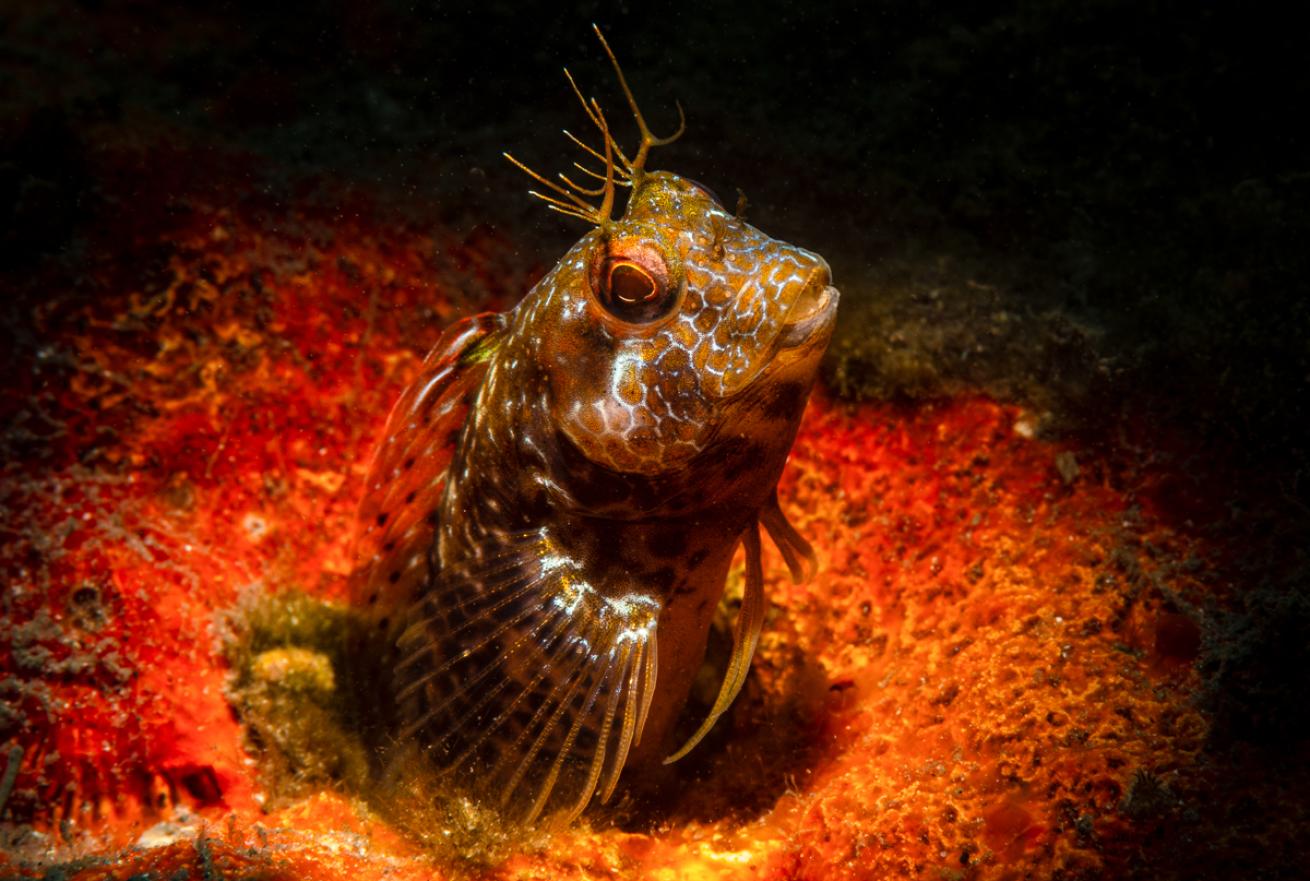
Brandon ColeA seaweed blennie stands at attention.
This Beach Has Teeth
Sharks were to officially take center stage in the second phase of this double-feature dive extravaganza. I was Bahamas bound—first stop: Tiger Beach. Crossing over the Gulf Stream at night, this time on the liveaboard vessel Shear Water, I couldn’t help wondering what was happening below, what miniscule whatchamacallits were astir in the blackness. I reminded myself that my focus for the next week would have to shift to larger quarry. (Though I chose to make the 67-mile journey from West Palm Beach to West End on Grand Bahama Island via liveaboard boat, flying Fort Lauderdale to Freeport and then utilizing Bahamas-based day-boat charters is an easy, popular alternative to dive Tiger Beach.)
My first visit to Tiger Beach was 20 years ago, before it became a household name in scuba circles. Fact check: This is not a conventional tropical beach on which one luxuriates in a hammock strung between palm trees, beverage in hand. Rather, it’s an extensive system of submerged sand banks and shallow reefs spreading out for miles in an arc north of Grand Bahama Island. This beach has teeth—lots of them, owned by lots of sharks. And not only tigers. Bulls, Caribbean reefs, lemons, and nurse sharks are also in residence, in abundance. Elasmokind thrive in these warm, azure waters, thanks to the Bahamian government’s staunch protection.
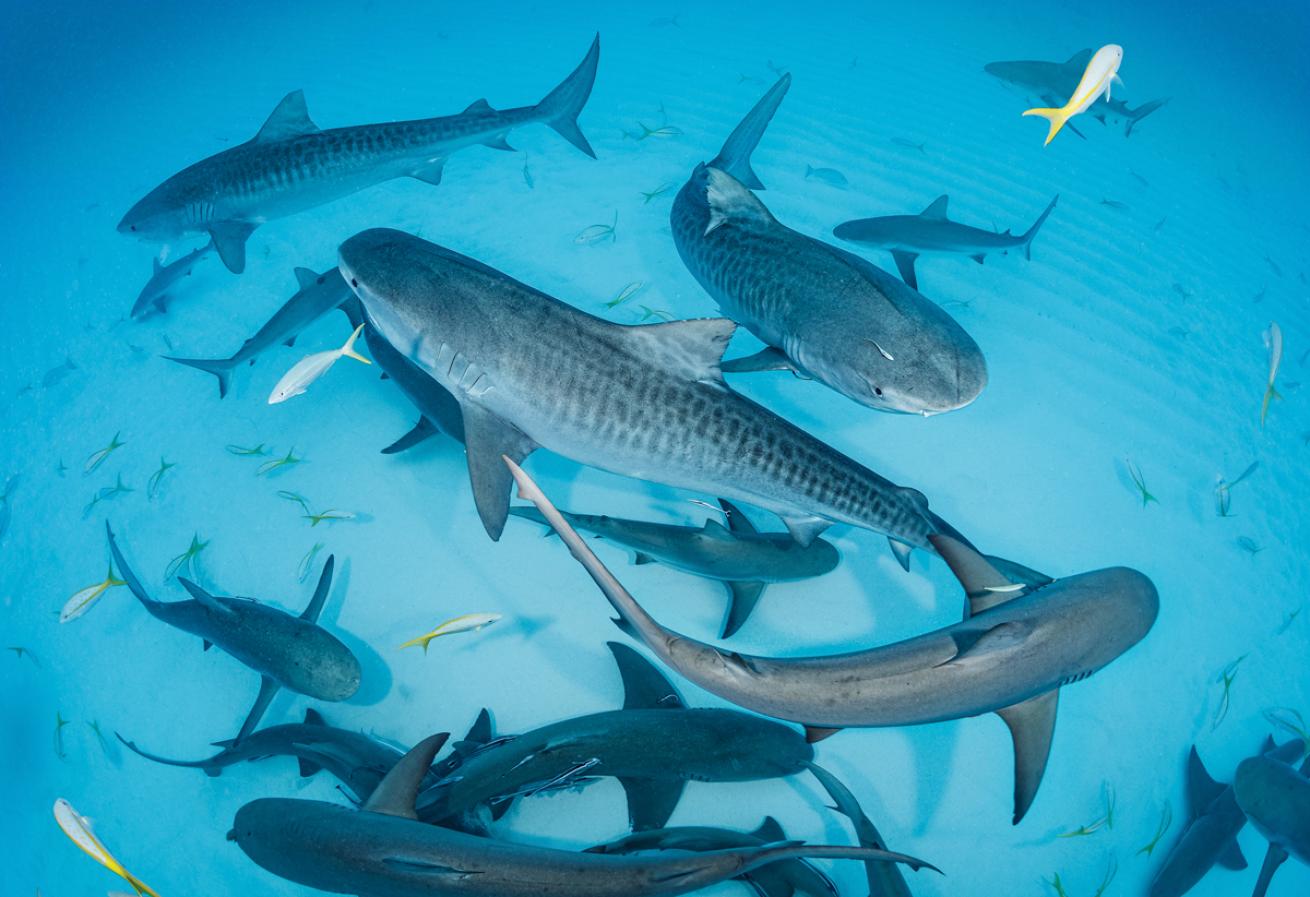
Brandon ColeA gang of tiger, lemon and Caribbean reef sharks prowls a shallow bank in the Bahamas.
We began at Wild South, eager for action. Kneeling on the sandy bottom 30 feet deep, 10 of us lined up in V-formation, split five and five either side of our metal bait box. Its name was Titanic. All praise its powers of attraction. Within five minutes, a half dozen Caribbean reef sharks had appeared. Then a couple of snaggle-toothed lemons. Next, the tiger sharks started trickling in. In time, we had four on scene, plus 30-odd reef sharks. We were in the middle of a right and proper sharknado. Far from terrifying, it was glorious. I was most definitely back in my element.
We were even more heavily outnumbered at the site named Blue Pride. The sheer amount of shark biomass was staggering. We stayed on the sand for two tanks, with at least 25 lemon sharks gliding low to the bottom while twice that many reef sharks rode the thermals higher up in the water column. Sharp, clear water moved in with the high tide. Visibility stretched 80 feet, but it was a challenge to see the lovely blue horizon for all the sharks in the way. When we moved to the adjacent coral reef for dives three and four, all eyes were on the tigers majestically patrolling back and forth among sea fans and sponges. Strategic bait positioning by divemaster Hex created makeshift photo studios for photographers and videographers keen to capture colorful wide-angle reef scenes with sharks in the background.
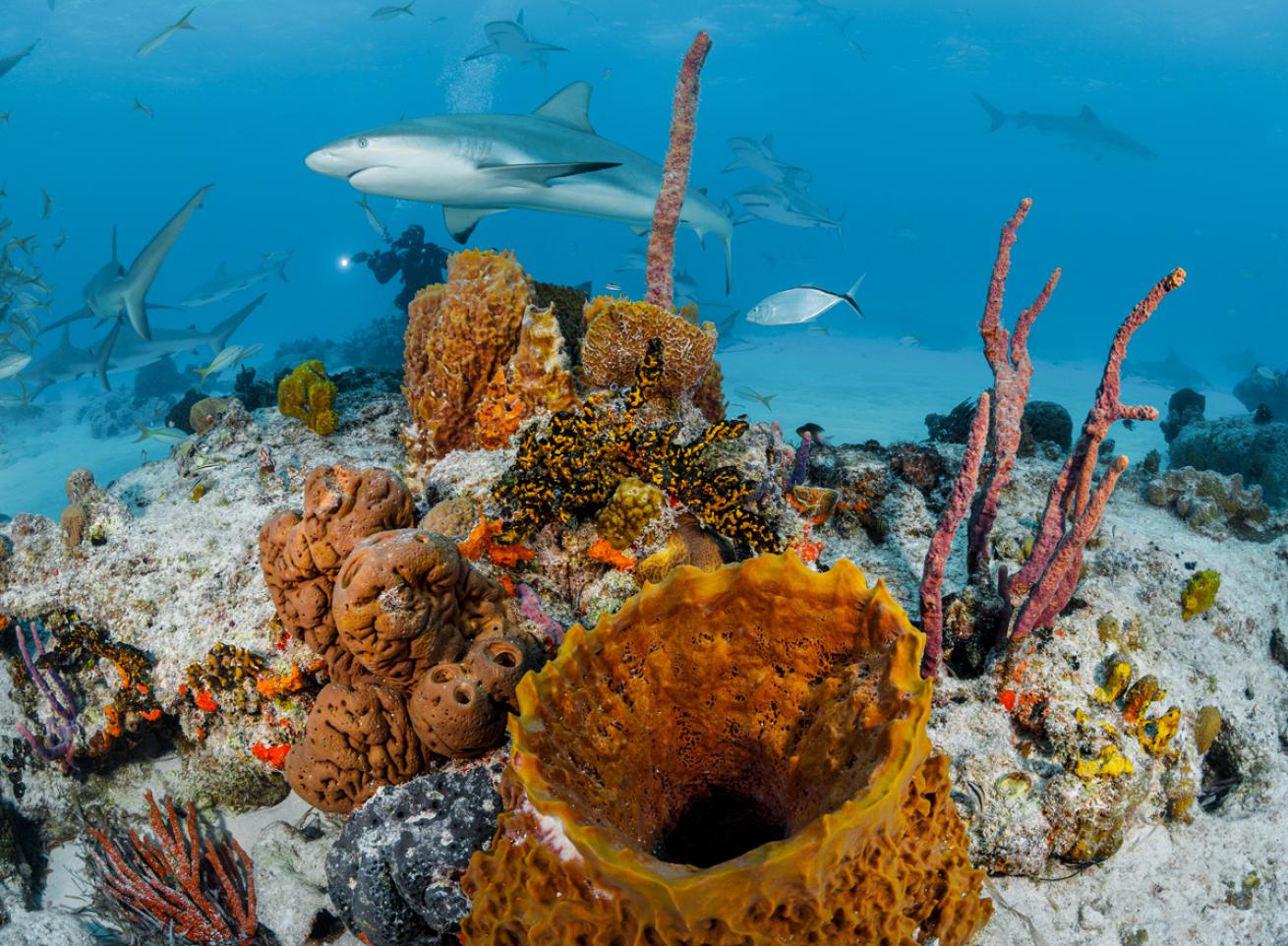
Brandon ColeReef Sharks in the Bahamas.
“Head on a swivel.” Wise words to live by when in close proximity to so many apex predators. Maestro Jim, conductor of our shark symphony finale at Tiger Eden, stressed this point over breakfast before we abandoned ship for a better place down under. A place where you must remain ever vigilant, hyperaware of what’s happening all around you, especially when fortunate enough to have eight different tiger sharks circling about. That’s tons of tigers, literally. Most were in the 6- to 9-foot range, but one girthy female was 12 feet long, which according to the interweb means she alone weighed in the neighborhood of 1,000 pounds. Though tiger sharks are well-equipped to cause irreparable damage, we saw no signs of aggression, no frenzy, nothing like Shark Week’s worst. Instead, we reveled in the company of one of the ocean’s most impressive creatures as they calmly, almost politely, swam among us. Of course there was the mandatory gut-clenching, visceral reaction when these beauties loomed just a foot above me, close enough for me to clearly see their serrated chompers and down that cavernous gullet, but that was simply my primeval lizard brain telegraphing across the eons. That emotional current ran below those of exhilaration and respect. In truth I was fascinated, not afraid. We logged four amazing dives that day—and came back to tell the tales—because we dived smart and safe, following to a tee the crew’s protocols.
Hammer Time
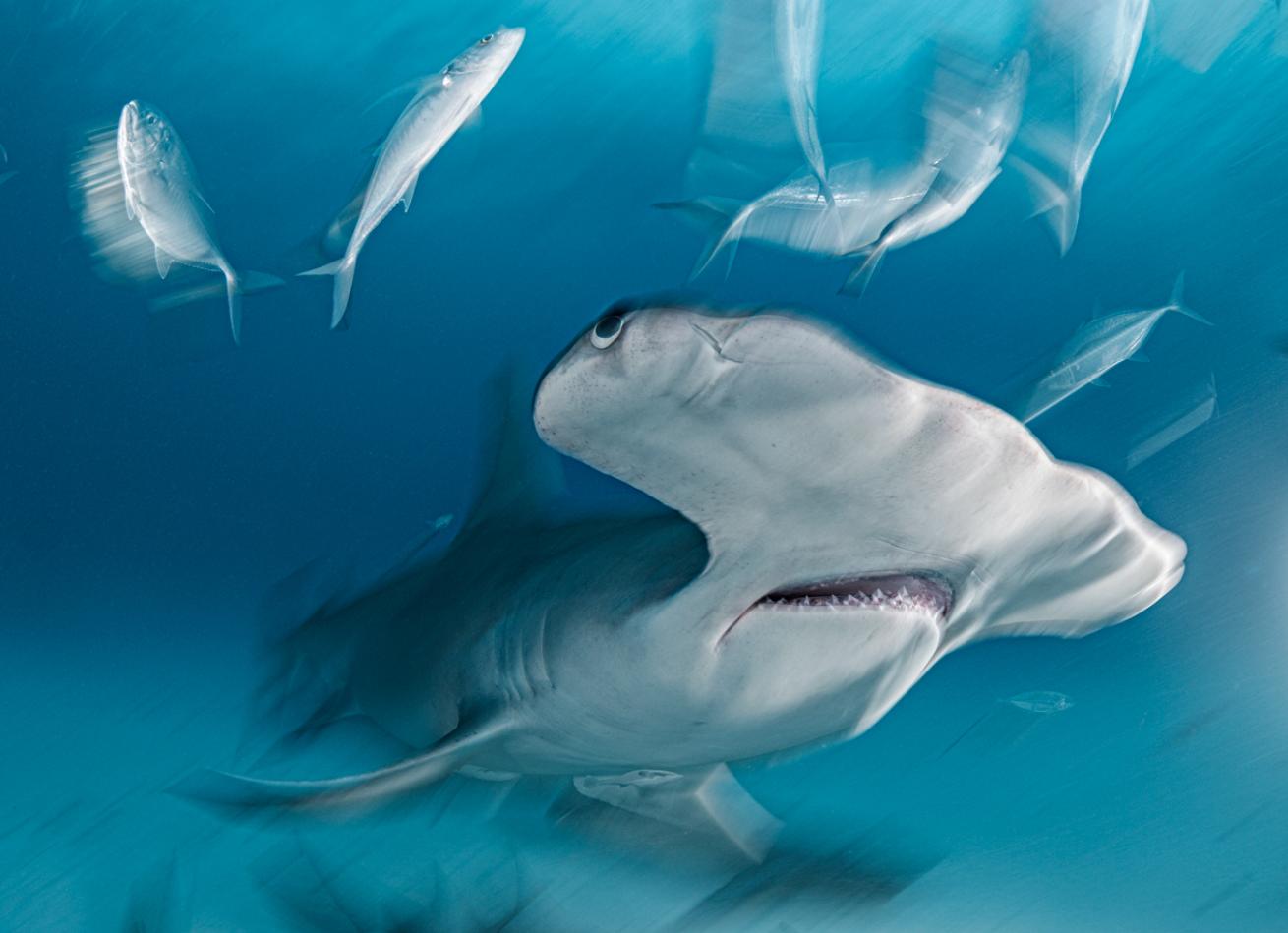
Brandon ColeA Hammerhead blurs by in the Bahamas.
The eight-hour overnight crossing from Tiger Beach to Bimini was a rough one. It gave me time to reflect on the mission’s success so far, and almost—it was touch-and-go for a bit—the opportunity to enjoy dinner a second time. I awoke to flat seas, sprang out onto the dive platform, and celebrated the new day with a happy dance. Anchored in the lee of Bimini Island, a mere 50 miles from Miami, we were floating above world-famous Hammerhead Highway, the premier place on the planet to encounter a shark like no other. When pressed to name a favorite species of shark, Sphyrna mokarran is the creature that comes steamrolling into my consciousness. It has always been thus. While other boys yammered on about Legos or firetrucks, it was the great hammerhead shark for me.
Waiting for Titanic’s odoriferous siren song to work its magic, I hummed into my reg and tried to prepare myself for a hammer’s arrival. It might take but a few minutes, or many hours. It’s possible to totally strike out, but in recent years sightings have been excellent in winter months, especially from January to March. I got to thinking about how dramatically this exercise contrasted with the black-water dives. In Bimini I rested comfortably on a bright, sandy bottom barely 30 feet deep. I had one target, knew exactly what I was likely to see, and I did not need to move anywhere or pull out a magnifying glass. I simply had to wait patiently for the action to come to me—or more accurately, to the bait. With black-water, we floated aimlessly about in unfathomable plankton soup—the best spoonfuls could have been anywhere. Also, there was that not-insignificant contrast between a larval fish the size of a rice grain and the 10-foot-long monster that shattered my reverie at the 56-minute mark as it charged up the Highway like a Klingon battle cruiser.
It was magnificent, dark and ominous, all angles and attitude. Its dorsal fin resembled an orca’s and towered over me. The impossible head swung left and right over the seafloor, scanning, scanning, its network of electroreceptors collecting and delivering sensory data lightning quick to the command center for processing, directing it onward. The shark accelerated, then braked hard, turned on a dime, and commenced to orbit Titanic, relentless. On each rotation, I stared, mesmerized, into the huge, imperious eye orphaned by evolution from its distant twin.
I spent seven hours underwater that day, and six the next, meeting four if not five different great hammerheads. Size, markings like birthmarks on their bellies, scars on fins and flanks, and even personality help in reliably identifying individuals. Jim and Hex introduced us to Queenie, Gaia, and Atlas, three rock-star hammers regularly seen in Bimini. Being acclimated to divers, they confidently weaved between our ranks, sometimes even brushing up against us. Observing these three individuals interact with each other was captivating. There obviously was a pecking order in place, with Queenie lording it over the others. Her presence was so commanding, her desire to own the bait so indomitable, I surely would have deferred to her had I been in her clan.
The Last Dive
Back in Florida, I boarded the boat under a pale sickle moon. This was my final shot at black-water. The underwater photographer grapevine was on fire with reports that folks had spotted a larval bony-eared assfish (yes, this spectacular creature really does exist...look it up) while I was overseas in the Bahamas chasing sharks. Consequently, I was incredibly envious. Who wouldn’t die to see this? Or a ribbonfish? A blanket octopus, female paper nautilus, pancake batfish, et cetera, et cetera? Sighting any of these pelagic phenomena would certainly cap an exceptional trip, not to mention reestablish perfect buoyancy in my life.
I powered on my lights and descended into the black, in hot pursuit of the unknown.
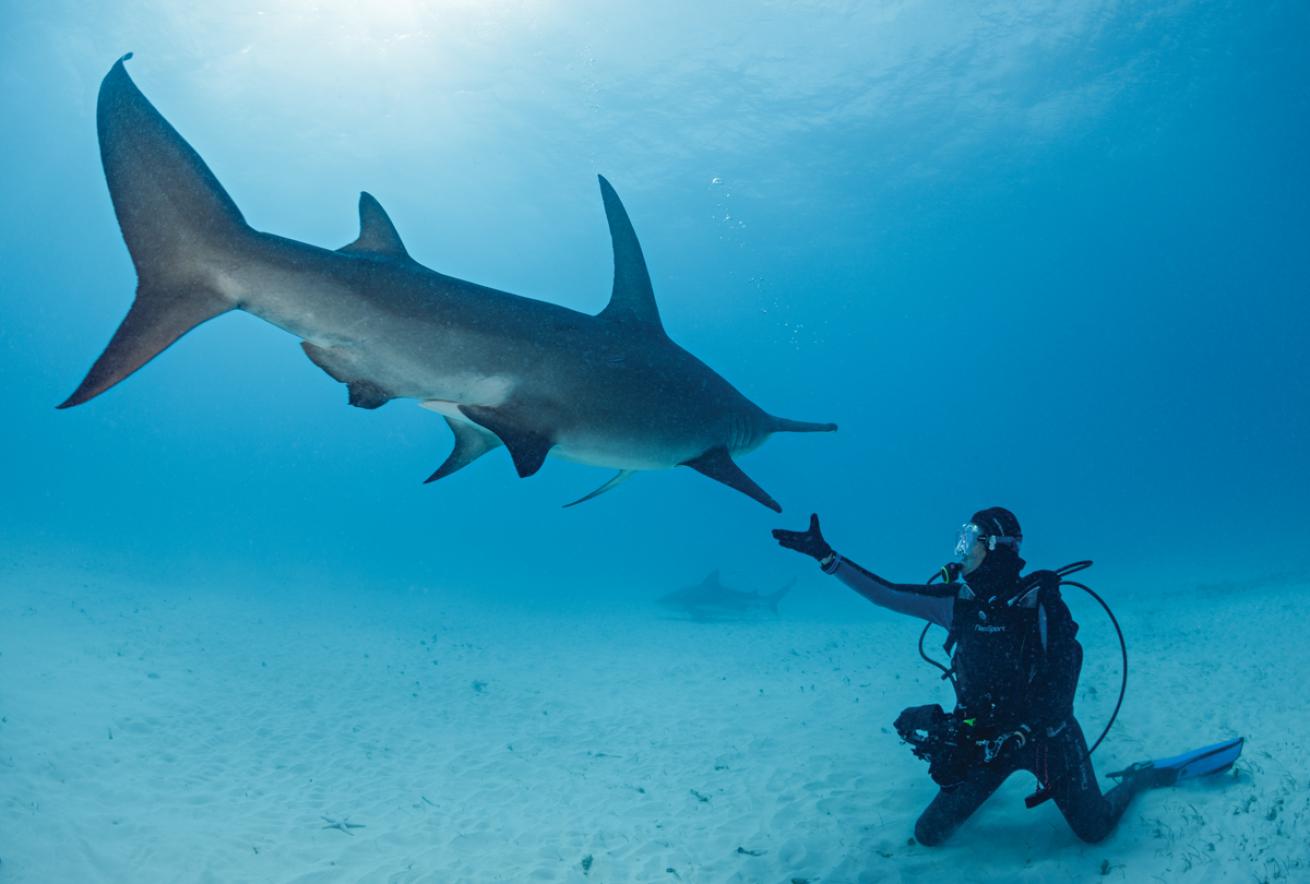
Brandon ColeAn exhilarating encounter with a great hammerhead (Sphyrna mokarran) at Bimini Island, Bahamas.
Need To Know
When to Go
Diving is possible year-round in Florida and the Bahamas. Black-water diving out of West Palm Beach is very weather-dependent, however. Charters will cancel on nights with rough sea conditions. Spring and summer months generally offer more favorable conditions for black-water than fall and winter, but good weather (and bad) can manifest at any time. Tiger Beach is reliably sharky throughout the year. Weather is highly variable there too. For great hammerheads in Bimini, one should target December through early April.
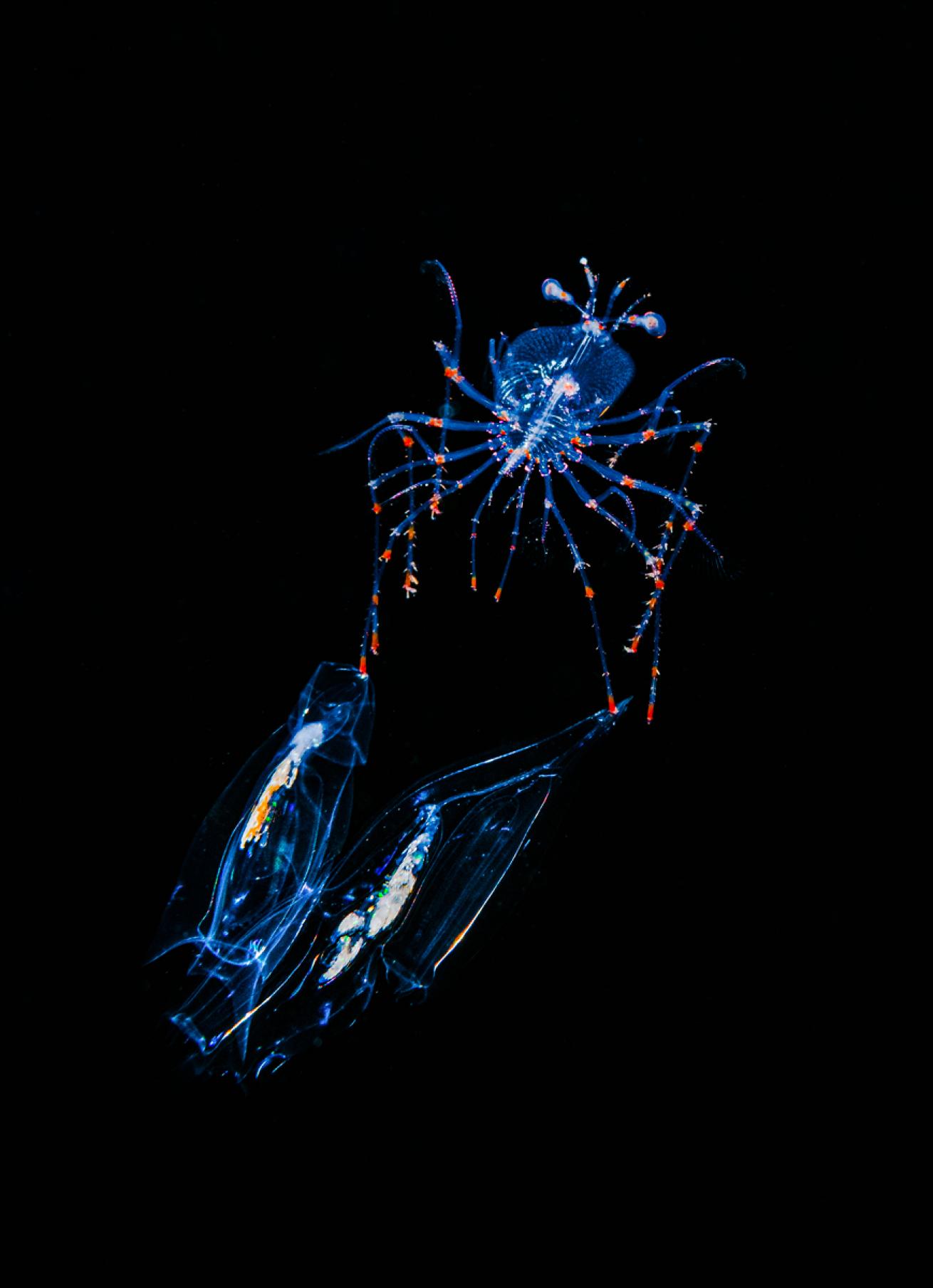
Brandon ColeA larval spiny lobster grabs onto two siphonophores.
Traveler Tips
Book at least a few nights of black-water to help mitigate weather cancellations and also to maximize your chances of finding cool critters. Reserve early, as availability is often limited. Carry at least two LED lights for spotting, ideally with both spot and wide-beam capability. For shark diving in the Bahamas, consider both liveaboards and land-based platforms. There are pros and cons to both. Liveaboards usually offer more dives per day. Traveling by boat instead of plane from Florida to the Bahamas and back allowed the author to log even more dives, since he did not have to skip days to off-gas before air travel. Land-based accommodations generally offer more personal space and a more stable bed.
Dive Conditions
Sea temperatures fluctuate with the seasons from the low 70s to the mid-80s. The Gulf Stream is usually a few degrees warmer than coastal waters. Wear a skin or 3 mm wetsuit in the summer and a full 5 or 7mm wetsuit in winter. (Many Bahamian shark diving operators require guests to wear full skins or suits dark in color.) Visibility varies from 30 to 100 feet. Current is always present in the Gulf Stream, but since this is a live boat drift dive you just go with the flow. Make sure you have a surface marker buoy. Black-water divers should have solid buoyancy skills as the dives are untethered in Florida. Shark diving in the Bahamas demands strict adherence to safety protocols.
Dive Support
- Walker’s Dive Charters in West Palm Beach for the black-water dives
- Jim Abernethy’s Scuba Adventures for the liveaboard trip from West Palm Beach to Tiger Beach and Bimini and back.










